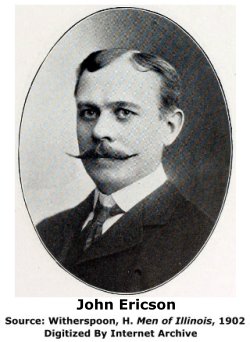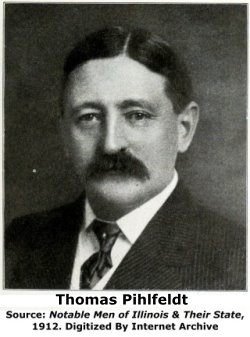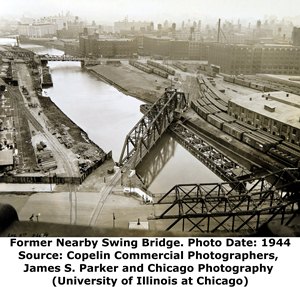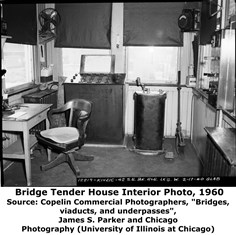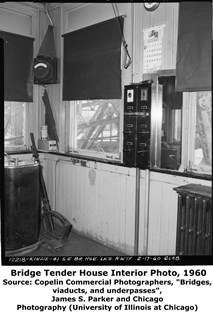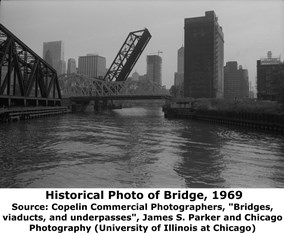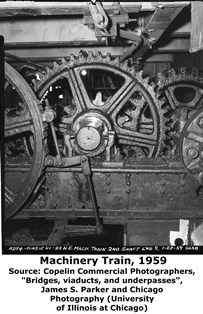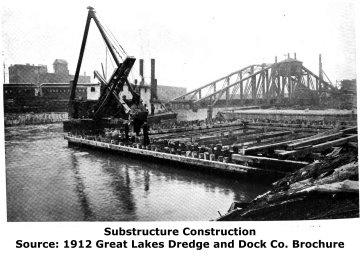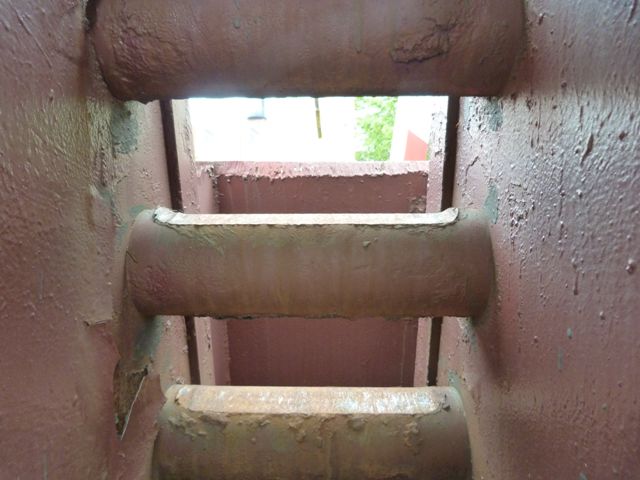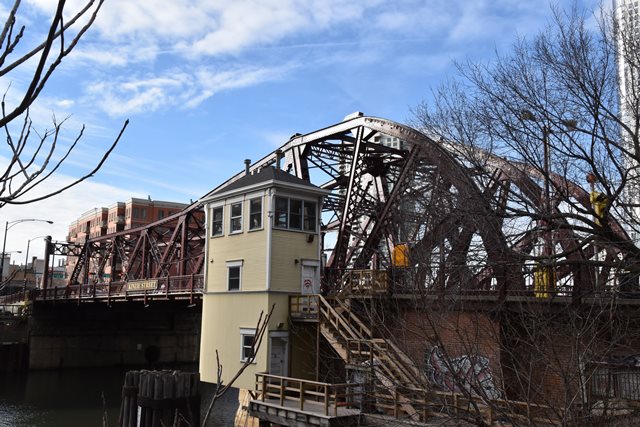We Recommend:
Bach Steel - Experts at historic truss bridge restoration.
BridgeHunter.com Phase 1 is released to the public! - Visit Now
Kinzie Street Bridge
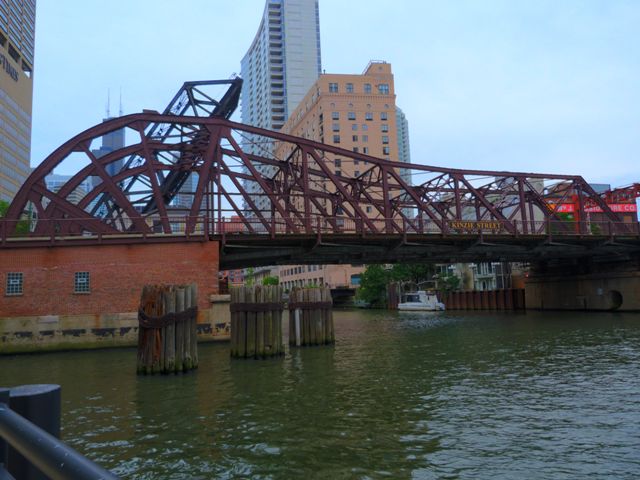
Primary Photographer(s): Nathan Holth
Bridge Documented: March 26, 2006 - June 13, 2021
Chicago: Cook County, Illinois: United States
Metal Rivet-Connected Pratt Through Truss, Movable: Single Leaf Bascule (Fixed Trunnion) and Approach Spans: Metal Stringer (Multi-Beam), Fixed
1909 By Builder/Contractor: John J. Gallery and Engineer/Design: City of Chicago
1999
136.2 Feet (41.5 Meters)
195.0 Feet (59.4 Meters)
36 Feet (10.97 Meters)
1 Main Span(s) and 2 Approach Span(s)
16602826628

View Information About HSR Ratings
Bridge Documentation
View Archived National Bridge Inventory Report - Has Additional Details and Evaluation
View Historic American Engineering Record (HAER) Documentation For This Bridge
HAER Data Pages, PDF
View A Modern Article Discussing Thomas Pihlfeldt
View A Historical Article About A Type of Deck Originally Used On This Bridge
Built in 1909, this bridge is the only remaining single leaf Chicago bascule bridge from what is called the "first generation" design that is a through truss. All the other such bridges are double-leaf. Indeed, single-leaf bascule bridges are extremely rare among the movable highway bridges in Chicago, nearly all are double-leaf. In contrast, railroad bascule bridges are nearly always single leaf including the historic railroad bascule bridge that sits next to the Kinzie Street Bridge.
Kinzie Street was the site of the first river bridge in the Chicago area. It was a foot bridge completed in 1832, reportedly built to provide better access to a tavern. The next bridge was built in 1870 by Fox and Howard and was a hand-turned iron/wood combination swing bridge that was 170 feet long and 31.5 feet wide.
When time came to replace the old 1870 swing bridge at this location, a temporary bridge was built and opened to traffic December 11, 1907. By December 16, work to remove the old bridge had begun. Construction of the bridge seen today started with the driving of the substructure piles on January 23, 1908. By September 26, 1908 the substructure was completed to the point that superstructure erection could begin, although superstructure erection did not begin until October 15. The superstructure was completed and the bridge opened to traffic May 10, 1909. The bridge substructure was essentially complete by November 13. The substructure cost $99,058.57. The superstructure cost $100,691.73. The total cost of the entire bridge was $218,707.86. John J. Gallery was listed as the superstructure contractor, while the substructure contractor was Great Lakes Dredge and Dock Company.
Approximately three quarters of this bridge has been replaced, but replaced in-kind using built-up beams that have been specially made to replicate the original elements of the bridge. The portion that replaced was that portion that is opposite the mechanics of this single-leaf bascule bridge, the front portion seen in the above photograph, which was taken facing eastward. While the primary goal with any historic bridge should be to preserve as much original material as possible, whenever something is replaced, it should be the goal to replace in-kind with as accurate a replica as possible. While it would be nice to see a greater quantity of original material on this bridge, this is nevertheless a good example of how a bridge beyond repair or nearly beyond repair might still be able to display the features which give it historic value. The only major shortcoming of the replacement is that standard high strength bolts were used instead of rivets. If rivets were used it appears it would be a perfect replication. From an aesthetic standpoint, the city could have partially simulated the appearance of rivets by using round head bolts which would make the bolts look more like rivets than the hex heads on the standard bolts the city used.
The photo below shows the rehabilitation/reconstruction of the bridge, specifically where the replicated section of the bridge is being put into place with assistance of a barge.
Above: This photo showing the heavy rehabilitation and reconstruction shows the portion of the bridge that is either completely or nearly completely made of new materials, which is the bascule leaf, being floated into place on a barge.
Above: When researching this bridge, you may come across historical photos (like the one seen in the advertisement and photo above) which show a mysterious bobtail swing bridge a short distance north of the Kinzie Street Bridge. This was the Chicago, Milwaukee, and St. Pail Railway Bridge, and this bridge and section of railroad line no longer exist.
Above: Photos from 1960 showing the interior of the bridge tender house.
Above: A photo of the bridge as it appeared in 1949.
Above: This photo showing bridge construction at a point where the bascule leaf is complete, but the deck is still being installed.
![]()
Historic Bridges of Chicago and Cook County


Chicago and Cook County are home to one of the largest collections of historic bridges in the country, and no other city in the world has more movable bridges. HistoricBridges.org is proud to offer the most extensive coverage of historic Chicago bridges on the Internet.
General Chicago / Cook County Bridge Resources
Chicago's Bridges - By Nathan Holth, author of HistoricBridges.org, this book provides a discussion of the history of Chicago's movable bridges, and includes a virtual tour discussing all movable bridges remaining in Chicago today. Despite this broad coverage, the book is presented in a compact format that is easy to take with you and carry around for reference on a visit to Chicago. The book includes dozens of full color photos. Only $9.95 U.S! ($11.95 Canadian). Order on Amazon.
Chicago River Bridges - By Patrick T. McBriarty, this is a great companion to Holth's book shown above. This much larger book offers an extremely in-depth exploration of Chicago's movable highway bridges, including many crossings that have not existed for many years. Order Now Direct From The Publisher! or order on Amazon.
View Historic American Engineering Record (HAER) Overview of Chicago Bascule Bridges (HAER Data Pages, PDF)
Chicago Loop Bridges - Chicago Loop Bridges is another website on the Internet that is a great companion to the HistoricBridges.org coverage of the 18 movable bridges within the Chicago Loop. This website includes additional information such as connections to popular culture, overview discussions and essays about Chicago's movable bridges, additional videos, and current news and events relating to the bridges.
Additional Online Articles and Resources - This page is a large gathering of interesting articles and resources that HistoricBridges.org has uncovered during research, but which were not specific to a particular bridge listing.
This bridge is tagged with the following special condition(s): Unorganized Photos
![]()
Photo Galleries and Videos: Kinzie Street Bridge
Structure Overview
Original / Full Size PhotosA collection of overview photos that show the bridge as a whole and general areas of the bridge. This gallery offers photos in the highest available resolution and file size in a touch-friendly popup viewer.
Alternatively, Browse Without Using Viewer
![]()
Structure Details
Original / Full Size PhotosA collection of detail photos that document the parts, construction, and condition of the bridge. This gallery offers photos in the highest available resolution and file size in a touch-friendly popup viewer.
Alternatively, Browse Without Using Viewer
![]()
Structure Overview
Mobile Optimized PhotosA collection of overview photos that show the bridge as a whole and general areas of the bridge. This gallery features data-friendly, fast-loading photos in a touch-friendly popup viewer.
Alternatively, Browse Without Using Viewer
![]()
Structure Details
Mobile Optimized PhotosA collection of detail photos that document the parts, construction, and condition of the bridge. This gallery features data-friendly, fast-loading photos in a touch-friendly popup viewer.
Alternatively, Browse Without Using Viewer
![]()
Additional Unorganized Photos
Original / Full Size PhotosA supplemental collection of photos that are from additional visit(s) to the bridge and have not been organized or captioned. This gallery offers photos in the highest available resolution and file size in a touch-friendly popup viewer.
Alternatively, Browse Without Using Viewer
![]()
Additional Unorganized Photos
Mobile Optimized PhotosA supplemental collection of photos that are from additional visit(s) to the bridge and have not been organized or captioned. This gallery features data-friendly, fast-loading photos in a touch-friendly popup viewer.
Alternatively, Browse Without Using Viewer
![]()
Bumpercam: Westbound Crossing
Full Motion VideoNote: The downloadable high quality version of this video (available on the video page) is well worth the download since it offers excellent 1080 HD detail and is vastly more impressive than the compressed streaming video. Streaming video of the bridge. Also includes a higher quality downloadable video for greater clarity or offline viewing.
![]()
Maps and Links: Kinzie Street Bridge
Coordinates (Latitude, Longitude):
Search For Additional Bridge Listings:
Bridgehunter.com: View listed bridges within 0.5 miles (0.8 kilometers) of this bridge.
Bridgehunter.com: View listed bridges within 10 miles (16 kilometers) of this bridge.
Additional Maps:
Google Streetview (If Available)
GeoHack (Additional Links and Coordinates)
Apple Maps (Via DuckDuckGo Search)
Apple Maps (Apple devices only)
Android: Open Location In Your Map or GPS App
Flickr Gallery (Find Nearby Photos)
Wikimedia Commons (Find Nearby Photos)
Directions Via Sygic For Android
Directions Via Sygic For iOS and Android Dolphin Browser
USGS National Map (United States Only)
Historical USGS Topo Maps (United States Only)
Historic Aerials (United States Only)
CalTopo Maps (United States Only)

